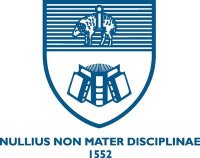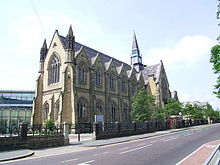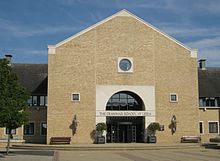Type a search term to find related articles by LIMS subject matter experts gathered from the most trusted and dynamic collaboration tools in the laboratory informatics industry.
| Leeds Grammar School | |
|---|---|
 | |
| Address | |
 | |
Alwoodley Gates Harrogate Road , , LS17 8GS England | |
| Coordinates | 53°51′54″N 1°31′07″W / 53.86503°N 1.51851°W |
| Information | |
| Type | Private school Grammar school |
| Motto | Nullius Non Mater Disciplinae (Nothing if not the Mother of Learning) |
| Established | 1552 (1341) |
| Founder | William Sheafield |
| Local authority | City of Leeds |
| Age | 4 to 18 |
| Enrolment | c. 1,500 |
| Houses | Thorseby, Clarell, Neville, Barry, Harrison, Sheafield, Ermystead, Lawson |
| Publication | Leodiensian |
| Merged | 2008 |
Leeds Grammar School was an independent school founded 1552 in Leeds, West Yorkshire, England. Originally a male-only school, in August 2005 it merged with Leeds Girls' High School to form The Grammar School at Leeds. The two schools physically united in September 2008.
The school was founded in 1552 by William Sheafield to provide free, subsidised or fee-paying education to the children of the City of Leeds. Despite 1552 being the traditional date for the foundation of the school, there is some evidence to suggest that the school existed as early as 1341. In 1805, the school was the subject of a ruling by Lord Eldon that set a precedent affecting grammar schools throughout England.
Leeds Grammar School was founded in 1552, following the death of the Reverend William Sheafield in July of that year. Sheafield left £14 13s. 4d. in his will to maintain a schoolmaster "to teach and instruct freely for ever all such Younge Schollars Youthes and Children as shall come and resort to him from time to time to be taught instructed and informed", provided that a school house was built by the town of Leeds.[1] The date for the school's foundation remains in doubt. Records indicate that there was a grammar school in Leeds as early as 1341. The school's first site is thought to have been in The Calls, by the River Aire, near the centre of the city. By about 1579 the school was in the New Chapel building at the head of Headingley Lane, where it remained until 1624. That year John Harrison, a great Leeds benefactor, removed the school "to a pleasant Field of his own which he surrounded with a substantial Wall and in the midst of the Quadrangle built the present Fabrick of the school". Harrison's school was on North Lane, on the site of the Grand Theatre opposite St John's Church. Through the years, the school grew steadily in numbers and reputation. Harrison's building was added onto in the 1640s by a new library, thanks to the endowment of Godfrey Lawson (Mayor of Leeds, 1669–70). The Lawson Library remains with the school (although it has moved to a number of different physical locations) making it the oldest library in Leeds. It was refurbished in 2007.
Towards the end of the 18th century, demand for Latin and Greek was falling, while Leeds was growing as a centre of commerce and industry. In 1791 the trustees proposed to appoint a third master, to teach writing and accounts, and a fourth to teach French and other modern languages. The plan was opposed by the master and usher. With the two sides unable to agree, a suit in the Court of Chancery began in 1795. In 1805, Lord Eldon, the Lord Chancellor, in a ruling that set a precedent for grammar schools across the country, proclaimed, "There is no authority for thus changing the nature of the Charity, and filling a School intended for the purpose of teaching Greek and Latin with Scholars learning the German and French languages, mathematics, and anything except Greek and Latin." He offered as a compromise that other subjects might be taught, as long as all boys also learnt the classical languages. On the death of the master in 1815, the trustees appointed one of their number as acting master, and effected the desired changes.[1][2][3]

By 1857, Leeds was growing prodigiously during the Industrial Revolution. The city conditions were dirty and Harrison's buildings inadequate for a Victorian education. In 1857 the decision was made by Rev. Alfred Barry (Headmaster) to move the school to new premises next to Woodhouse Moor. The building, in Gothic Revival style, opened in June 1859. The building was designed by Edward Middleton Barry, brother of the headmaster, Rev. Alfred Barry, after whom one of the eight houses was named. At that time the school roll numbered fewer than 100 boys and the buildings were planned for 200. Serious consideration was given in the 1920s to moving the school to Lawnswood – the current site of Leeds University's playing fields.

The school was in the direct grant scheme in the 1950s to 1970s, and the assisted places scheme in the 1970s to 1990s. Throughout the 20th century the school continued to expand, with the building of a swimming pool, sports hall, theatre, a design and technology department, assembly hall and classroom block. By the 1990s, the roll had risen to over 1,100 boys and the school operated on three separate sites. Despite continuous improvements to accommodate increased numbers and the requirements of a contemporary curriculum, no further development of the facilities was economically viable without great detriment to the education of the pupils. The area of Leeds surrounding the school, Hyde Park, was in decline and the University of Leeds was also seeking to expand and so the decision was taken by the school governors and the university to exchange the Woodhouse Moor, Junior School and Lawnswood premises for a university-owned 138-acre (0.56 km2) site in Alwoodley to the north of Leeds. The Woodhouse Moor premises are now occupied by Leeds University Business School.

In September 1997, at a cost of £18.5 million and after three years’ construction, Leeds Grammar School opened in Alwoodley Gates. In 1999 a new Headmaster Dr Mark Bailey was appointed. Following the shrinking of Leeds' child population, staff shortages and Leeds Girls' High School's need for more adequate modern buildings the decision was taken to merge with Leeds Girls' High School in 2003. The school passed out of existence on 4 July 2008, although it had been legally dissolved since August 2005.
Leeds Grammar School has eight houses, named after individuals connected with the school or its formation. This system dates back to 1924, with the original school houses being Clarell, Sheafield, Neville and Thoresby. Currently there are eight houses:
There are many competitions throughout the school year, the most notable of these being Sports day and House music. Any house activity, be it a win or a draw, results in the acquiring of House Points. All eight houses compete throughout the year for the coveted Bailey Cup – awarded at the end of the year for the house with the most House Points.
Following the merger with Leeds Girls High School four of these houses (Thoresby, Neville, Clarell and Barry) were removed. Four houses have been created from alumnae important to Leeds Girls High School (Eddison, Ford, Lupton and Powell) thereby maintaining the current eight-house system at GSAL.
The school administration merged with Leeds Girls' High School in August 2005, and the two schools physically merged in September 2008. At that time the Senior School (ages 11–18) and Junior School (ages 7–11) will remain at their present Alwoodley Site. The Infant School will move to the former LGHS site at Headingley alongside a new Nursery School. The merged school will be called The Grammar School at Leeds. The main Senior School site of Leeds Girls' High School will be sold to a private developer. Classes for girls and boys between the ages of 11 and 16 will remain segregated, but all extracurricular activities will be mixed.
The merger of the two schools has caused some controversy due to the expected increase in traffic levels at the Alwoodley site.[4]
Leodiensian is the name given to the school magazine of Leeds Grammar School; the first edition was published in October 1827, and it became a regular annual publication from 1882, making it one of the longest-running school publications. The name Leodiensian is derived from the Latin name for Leeds, Ledesia (and later Leodis), and in an adjectival form can be seen in the School Song, in the phrase "Leodenses cuncti".
A former pupil of Leeds Grammar School is described as an Old Leodiensian. In popular culture, Old Leodiensian features in the Kaiser Chiefs' song "I Predict a Riot":
"Would never have happened to Smeaton, an old Leodiensian"
The line features John Smeaton a famous pupil of the school, and was written by the Kaiser Chiefs' lead singer Ricky Wilson who is himself an Old Leodiensian.
Alumni from Leeds Grammar School are called "Old Leodiensians" or "Old Leo's". Notable Old Leo's include: